- About Us
- Columns
- Letters
- Cartoons
- The Udder Limits
- Archives
- Ezy Reading Archive
- 2024 Cud Archives
- 2023 Cud Archives
- 2022 Cud Archives
- 2021 Cud Archives
- 2020 Cud Archives
- 2015-2019
- 2010-2014
- 2004-2009
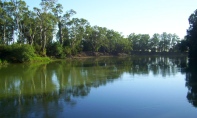 |
Paddling The Murray River |
At Times A Case Of 'Up The Creek With A Paddle But Without A Creek'
One hundred and eighty years ago this month (on 3 September 1829), Captain Charles Sturt left Sydney with a party of seven men, numerous horses, sheep, cattle and a 25 foot whaling boat, charged with charting the Murrumbidgee River and perhaps tracing it to an inland sea in central Australia. Sturt’s journey took him to the junction with the Murray River and then to the Murray Mouth at the Southern Ocean, where conditions prevented him from reaching his rendezvous offshore in Encounter Bay - forcing him to retrace his path back up the river.
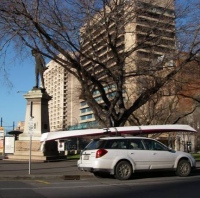
Sturt’s statue in Adelaide, with kayak ready to return home on the car, rather than paddling back upstream
In mid-July I too launched into the Murray, starting at Yarrawonga Weir (rather than on the Murrumbidgee), paddling alone for 32 days in a sleek Mirage 22s sea kayak full of camping gear (rather than the whaling boat and crew) and thankfully reached South Australian hospitality and my car at the end of the journey (to drive home, rather than paddle). Our respective diaries are similar though, both recording long days of hard work, often through quiet, un-inhabited meandering reaches of river. Over 32 days, I ended up paddling 1911kms, averaging roughly 60kms a day at 9kms an hour. Paddling at a solid 70 strokes a minute for much of the time, I now have a sense of the magnitude of the number – 1 million – as I roughly approached this number of paddle strokes. And considering the exertion, although I was not similarly encumbered by sheep and cows, I certainly ate plenty of both at riverside hotels to refuel after spending around eight hours on the water each day. Sturt’s expedition may well have carried beer, to allay the onset of scurvy – as Captain Cook had done so successfully on his voyages. So, in an attempt at historical accuracy, and to prevent scurvy on my own trip, my hearty mixed grill meals in country pubs were regularly accompanied by a Reschs, Carlton Draught or Coopers Pale Ale – depending on which state I’d moored in.
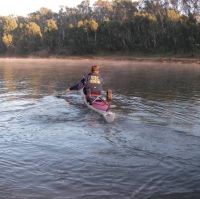
Setting out from Yarrawonga Weir on day one – 17 July 2009
A paddling trip is very much a matter of left and right: paddle strokes (half a million times each in this case) and banks of the river. Upstream of the South Australian border, the northern / right bank of New South Wales bears blue and white kilometre counters, supposedly every two kilometres, but more often than not these signs have been either souvenired or are attached to trees that are now submerged snags in the river itself. These marker signs are designed to count down the distance to the Southern Ocean, however the most common signs on the right bank are blunt private property signs (“PISS OFF, PRIVATE PROPERTY” being one of the more direct sentiments displayed on a landholding near Swan Hill). In contrast, the southern / left Victorian side affords the public a three chain (60 metre) crown reserve along the Murray, for not-so-private recreation, and often secluded camp sites at the end of a long day.
As for the river itself, the lady at the Barmah convenience store / post office / servo / cafe observed that “Someone’s pulled the plug.” I considered saying that we had all contributed to the river’s demise, but as she hadn’t yet delivered my much needed bacon and egg roll for morning tea, thought better of jeopardising it with a discussion on water management in Australia. In fact the plugs have very much been left in the river storages, with less than 1000 megalitres (Olympic swimming pools) flowing down the river on most of the days I paddled it. But she was right about the water ... July / August 2009 was not the best time of the year if looking for deep flowing water (nor frost fee mornings while camping, for that matter). A decade of record-low inflows into the Murray Darling Basin, have only exacerbated the regulation and over-extraction of the past century, and as I dragged my kayak across mid stream sand banks, ran into submerged logs, laboured through reaches full of duck weed and portaged around upstream weirs with insufficient water to use the lock chambers – I cursed our history of extraction from the river.
Inevitably though, by the end of each day when I aimed to reach riverside towns, I gratefully acknowledged that very same regulation and extraction that sustains the local communities. Another few feet of water and a roaring downstream flow would have been ideal for this paddler (to say nothing of the needs of the river red gums and aquatic life), but I wouldn’t have enjoyed the food and drink of the regions and the endless hospitality, if there were no dams in the system or pumps on the river bank. I may have ended up with scurvy without the beers too.
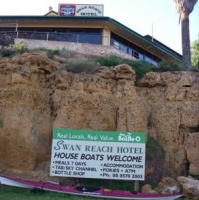
Hospitality on the river – the Swan Reach Hotel
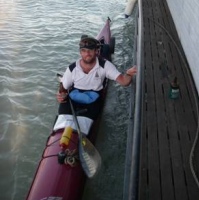
A beer and a houseboat into Waikerie, South Australia
A paddling trip is also about flow. Until roughly the halfway point of the journey, around the tiny Victorian settlements of Colignan and Nangiloc (Colignan spelt backwards), the Murray was shallow but flowed at a few kilometres an hour. Ominously, within half an hour of leaving Yarrawonga on the first day I’d run aground for lack of water and was left to wander a few metres downstream pulling the boat, and wonder about ‘walking the Murray’ instead. The second thousand kilometres of the journey was the opposite (perhaps shedding some light on the Nangiloc and Colignan relationship ...) with deep, still water, backed up behind the ten weirs that pool the river from Wentworth (where the Darling River joins the Murray) to Blanchetown in South Australia (where the Murray drops to a level below 0m AHD).
The flow is not just about the movement of the river, but also the paddling strokes marking the flow of seconds, minutes, hours in the boat. In the deliberate absence of an iPod or other music, the Creedence Clearwater Revival tune ‘Proud Mary’ often rolled into my head, amidst the quiet of the river – not just ‘Rollin’, rollin’, rollin’ on the river,’ but also ‘left a good a job in the city’ (if not ‘workin’ for the man ev’ry night ‘n’ day’). In a society of instant and overwhelming information, where there are endless twits-a-twittering and faces-booking, I slid slowly and steadily through an Australian landscape of quiet banks, cliffs, forests and natural life. The lyrics of another band - Tool (not often associated with Creedence, I wouldn’t have thought) also rolled through my thoughts when thinking about life away from the river – ‘constant over-stimulation numbs me,’ as I soon realised that you can’t speed up paddling 2000kms, there’s no instant-gratification or short cuts (well only a few), nor is there the cacophony of modern life once you’ve pushed off from the bank, paddle in hand.
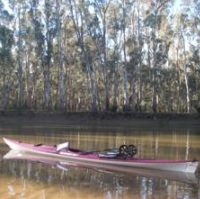
Upstream - run aground midstream early in the journey
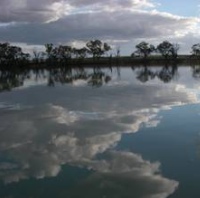
Downstream - depth but no flow in the weir pools
Aside from the numerous suggestions that my trip was like ‘Two men in a Tinnie’ or even ‘Deliverance’ many onlookers also observed that I must have resolved some of the big issues – water management in drought-ravaged Australia for example. Since returning to ‘the good job in the city’ many have assumed that I had plenty of time to think. Conversely and happily, I in fact had plenty of time to not think. Rather, the hours often flowed by - thinking of nothing more than merely gripping the paddle and levering the hull through the icy winter waters, scanning my deck top charts for the next bend in the river, taking in the water and the sky. Just paddling ...
One evening in Moama after a 76km paddling day, a lady even suggested that I might come across the meaning of life while paddling solo for such an extended period, and without prompting offered her life view that ‘there’s never enough of anything – money, water, time, etc.’ Once again I was hungry, so agreed with her to avoid delay on the Tuesday night $10 steak special at the Moama Bowls Club. I suspect if pressed on the issue I’d have relied on another set of lyrics - Pete Seeger’s take on Ecclesiastes 3:1 - ‘there’s a time for all things.’
As the lyrics go, there’s certainly ‘a time to keep and a time to cast away,’ whether it be irrigation water, environmental flows or anything else on the river. There were times on the Murray to put the head down and grind into gusty westerlies, times to roar downstream with a tail wind, and other times to pull into a town for a warm drink and a break.
After five weeks ‘rollin’ on the river,’ it had just been a good time to go for a paddle.
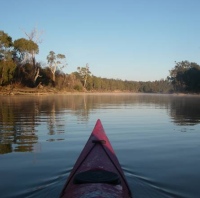
When not travelling and writing for The Cud, Wilf works at the Australian Government - National Water Commission and is studying a Masters, majoring in water science and water management at the Australian National University. The views in this article do not necessarily reflect the sentiments of these esteemed institutions.
